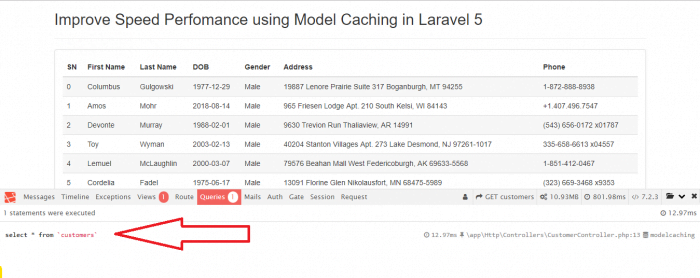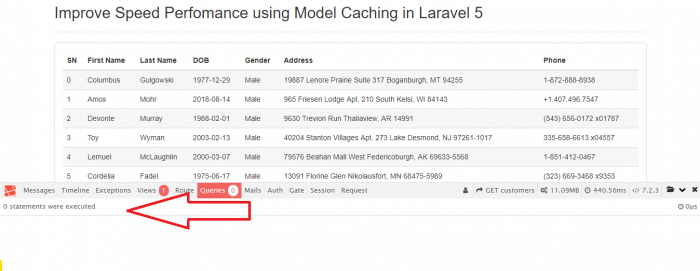There are various factors that affect the speed of an application. Among them, frequent database queries for the repetitive task is one. For these types of task, we can use Model Caching. We will do it for our fresh laravel project. So let’s get started implementing it in our project.
Create Project
We will create a new laravel project for this. Run the artisan command:
composer create-project laravel/laravel laravelmodelcaching
Database Setup
After creating project, we need to setup our database. Lets create a database named modelcaching and do necessary setup in .env file.
DB_CONNECTION=mysql DB_HOST=127.0.0.1 DB_PORT=3306 DB_DATABASE=modelcaching DB_USERNAME=root DB_PASSWORD=secret
Intall Laravel Debugbar
We are installing it to for the debugging purpose only. We will use it only in our development environment. To install it, run the command:
composer require barryvdh/laravel-debugbar --dev
Laravel 5.5 uses Package auto-discovery, so we don’t need to manually add the ServiceProvider.
Then, you can publish the configuration with command below:
php artisan vendor:publish --provider="Barryvdh\Debugbar\ServiceProvider"
Install Model Caching Package
This is our main package which enables to cache our models. You can find more information about this package in GitHub repository.
To install it, run the command:
composer require genealabs/laravel-model-caching
Create Model & Migration
We will create a customers table and respective model. Run the following command:
php artisan make:model Customer -m
This will create a migration file and a model. We will add some columns in customers table by changing in migration file. So, our migration file looks as below:
// database/migrations/customers migration file
public function up()
{
Schema::create('students', function (Blueprint $table) {
$table->increments('id');
$table->string('first_name', 100);
$table->string('last_name', 100);
$table->date('dob')->nullable();
$table->string('gender', 10);
$table->string('address', 100)->nullable();
$table->string('phone', 100)->nullable();
$table->timestamps();
});
}
Similarly, open your Customer model and make necessary changes to fit our migration.
// App/Customer.phpSince, we have already setup our migration, lets migrate our database. Run the command.
php artisan migrateDatabase Seeding
We will populate our database using faker package. You don't have to install any package. Laravel comes with this package. First of all let's create a seeder to populate customers table.
php artisan make:seeder CustomersTableSeederThis will create a seeder file inside
database/seeds/. We will populate 50 students.insert([ 'first_name' => $faker->firstNameMale, 'last_name' => $faker->lastName, 'dob' => $faker->dateTime, 'gender' => 'Male', 'address' => $faker->address, 'phone' => $faker->phoneNumber, 'created_at' => $faker->dateTime(), 'updated_at' => $faker->dateTime() ]); } } }Include this newly created seeder file inide run() function in
seeds/DatabaseSeederfile.public function run() { $this->call(CustomersTableSeeder::class); }All setup for seeding. Let's populate database by running command:
php artisan db:seedCreate Route
It's time to register a route in web.php file.
Route::get('customers', 'CustomerController@index');Create Controller
Lets create a controller file. Run the following command:
php artisan make:controller CustomerControllerOpen up our controller file and make some necessary changes.
// App/Http/Controllers/CustomerController.phpCreate Blade File
We have setup all our project and created routing, controller. Now, let's create view file inside customers directory. Our final blade file looks like below:
Improve Speed Perfomance using Model Caching in Laravel 5 Improve Speed Perfomance using Model Caching in Laravel 5
@foreach($customers as $key => $customer) SN First Name Last Name DOB Gender Address Phone @endforeach {{ $key }} {{ $customer->first_name }} {{ $customer->last_name }} {{ $customer->dob }} {{ $customer->gender }} {{ $customer->address }} {{ $customer->phone }} Testing
To test our application, run the project.
php artisan serveWe will test our application in two-phase i.e. firstly without implementing Model Caching and secondly, with model caching.
Testing without Model Caching
Below is a screenshot of result I have tested without using model caching.
Testing with Model Caching
To implement model caching we need to implement
Cachable Traitin our model. Thus, after implementation, our model looks like below:The above implementation of model caching resulted as below:
This is all for laravel model caching. I hope you have got a pretty clear idea about implementing model caching in laravel. If you have any question, please leave a comment below. I always appreciate your feedback.






